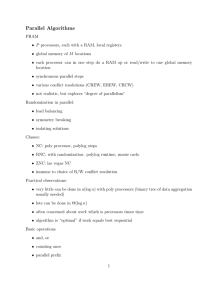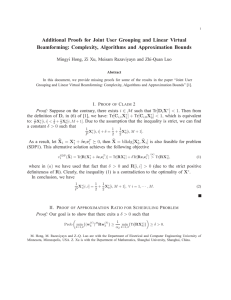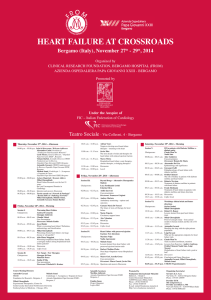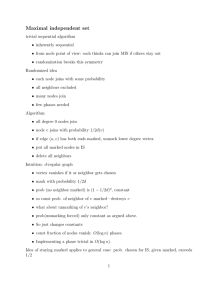Document 13600779
advertisement
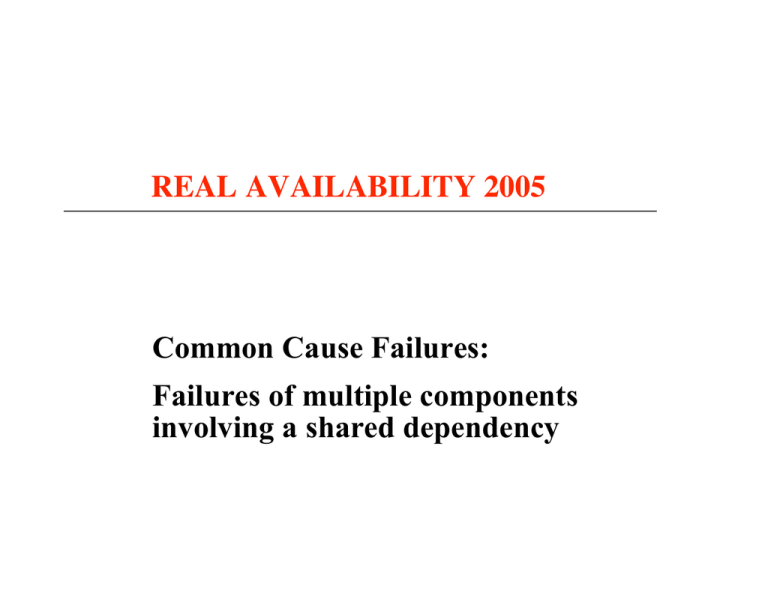
REAL AVAILABILITY 2005 Common Cause Failures: Failures of multiple components involving a shared dependency KEY POINTS OF THE SESSION Component Arrangements Common Cause Failures B Factor Method Data Center Common Cause Failures Dual Path and Dual Cord Fault Tree Analysis of Single-Cord, Dual Path, and Dual Cord Service 4-2 EXAMPLE OF COMMON CAUSE FAILURE SOURCES POTENTIALLY ABLE TO AFFECT DATA CENTERS SERIOUSLY Environmental (Exceeding Allowable Envelope) Support System Structural Fuel Quantity Temperature Manufacturing Flaw Fuel Quality Pressure Faulty Cooling Vibration Maintenance Lubrication Noise Procedure Ventilation Air Quality Component Design Error Human Error Electromagnetic Pulse Control Power Interfacing Switchgear External Earthquake Hurricane Tornado Flood Explosion Labor Strike Terrorist Action 4-5 TYPES OF COMMON CAUSE FAILURES AND THEIR ASPECTS Description of Failure Cause Hardware Examples Human Examples DEPENDENT STRUCTURAL* Failure of an interfacing A common material or system, action or design flaw which component simultaneously affects all components population • Loss of electrical power • A manufacturer provides defective replacement parts that are installed in all components of a given class • Following a mistaken leader • An erroneous maintenance procedure is repeated for all components of a given class • • • • Faulty materials Aging Fatigue Improperly cured materials • Manufacturing flaw • • • • Incorrect training Poor management Poor motivation Low pay ENVIRONMENTAL A change in the operational environment which affects all members of a component population simultaneously • High pressure • High temperature • Vibration EXTERNAL* An event originating outside the system which affects all members of a component population simultaneously • • • • • • • • • • • Common cause psf's New disease Hunger Fear Noise Radiation in control room Explosion Toxic substance Severe Weather Earthquake Concern for families Easy to Anticipate?: Component failure Human error High Very Low Medium Medium Medium Very Low Medium Medium Very Low, hard to design for mitigation Very Low, the factors making CCF likely also discourage being prepared for correction Low Low Low Low Easy to Mitigate?: Component failure High, if system designed for mitigation Human error High, if feedback provided to identify the error promptly * Usually there are no precursors 4-6 COMMON CAUSE (i.e., DEPENDENT) FAILURES Let CC Be a Common Cause Failure Event Causing Dependent Failures of Components A, B, C and D. The Component A Can Fail By 1. Independent Failure, Event Ai, Prob. = qA 2. Dependent Failure, Event (Ac• CC), Prob. = Prob.[Ac|CC] • Prob.(CC) = Prob.(CC) Ai (Ac• CC) Failure Prob.[Failure of Component A] = Prob.(Ai) + Prob. (Ac • CC) - Prob.(Ai) • Prob. (Ac • CC) Neglect, as Usually is of Small Value 4-7 COMMON CAUSE (i.e., DEPENDENT) FAILURES Consider Failure of Four Components: A, B, C, D Prob. [4 Component Failures ] = Prob. [A ⋅ B ⋅ C ⋅ D ] = Prob. [A (B⋅ C ⋅ D)] Prob.[B (C ⋅ D)]Prob.[C D]Prob.(D) Now Consider Events A, B, C, D Each to Have an Independent Version and a Version Dependent Upon Event CC, (Prob. (CC) = qcc ) Then Prob. (A ⋅ B ⋅ C ⋅D ) ≅ qA qB qC qD + Prob.[Ac (Bc ⋅ Cc ⋅ Dc)] Prob. [Bc (Cc ⋅ Dc ⋅CC)]Prob.[Cc (Dc⋅ CC )] ⋅Prob.(Dc CC)Prob.(CC) Prob.(Dc ⋅ CC) Or Prob.(A ⋅ B ⋅ C ⋅ D ) ≅ q A qB qC qD + 1 ⋅ qcc Independent Dependent 4-8 COMMON CAUSE (i.e., DEPENDENT) FAILURES Often Order ( q CC ) = Order ( q A, B, C, D ) >> q A q BqC q D ⇒ Prob. ( A⋅ B ⋅ C ⋅ D ) ≅ q CC In This Situation Redundancy of Components is of Little Benefit in Reducing Values of Prob. (A ⋅ B ⋅ C ⋅ D ) Then Prob.( A ⋅ B ⋅ C ⋅D) ≅ Prob.(Ai ⋅Bi ⋅ Ci ⋅ Di ) + Prob.(Acc ⋅ Bcc ⋅ Ccc ⋅ Dcc ⋅CC) i + independent failure c + dependent, or common cause failure 4-9 COMPONENT ARRANGEMENTS Parallel – A B Used When Success of a Single Component is Sufficient for System Success Three Component Systems N N Psystem = 1 − ∏ q i , for Independent Failures A Success C B S = A + B+ C =1− A⋅ B⋅C Failure i=1 ( Psystem = 1 − Qindependent − Q common + Q independent ⋅ Qcc cause N N = 1 − ∏ q i + q cc − q cc ⋅ ∏ q i i=1 i=1 Typically is small ) Success SCC 4-10 COMMON CAUSE FAILURE — β FACTOR METHOD • N components, each of which has an independent failure probability qI; • Common cause failure factor β; Let C be the event that common failure happens, P(C) = β qI; • If C happens, none of the N components can succeed; NOTE: Sometimes sharing a common cause among N components will result in m (m ≤ N) failing upon occurrence of the common cause. 4-11 NO COMMON CAUSE FAILURE If there is no common cause failure, i.e. β = 0. With N = 10, we obtain the following binomial distribution for X — the number of successful components. 10 k P(X = k) = (1 − qI ) q I10 −k , k k = 0,1,2,...,10 4-12 COMMON CAUSE FAILURE: β FACTOR METHOD (continued) • If β ≠0, X has the following distribution: P( X = 0) = P(X = 0 | C)P(C ) + P( X = 0 | C) P( C) 10 = 1 × βqI + (1 − qI )0 q I10 × (1 − β ) = βqI + (1 − β )q I10 ≈ βqI 0 k ≠0 P( X = k ) = P(X = k | C) P( C) + P( X = k | C)P(C ) 10 = 0 × βqI + (1 − qI )k qI 10 −k × (1 − βqI ) = (1 − βqI ) × k 10 ≈ (1 − qI ) k qI 10 − k k 10 (1 − qI )k q I 10 − k k 4-13 COMMON CAUSE FAILURE: β FACTOR METHOD (continued) • Common cause failure increased the probability that all components will fail dramatically. Take N = 10, qI = 0.01 as an example: – If β = 0 (no common cause failure), the probability that all 10 components will fail is 10 (1− 0.01) 0 0.011 0 = 0.011 0 = 10 −20 0 – If β = 0.01, the probability the common cause failure happens is P(C) = βqI=0.01×0.01=10-4. The probability that all 10 components 10 4 will fail is βqI +(1 − β)qI10 = 0.01 × 0.01 + (1 − 0.01) × 0.01 ≈10 − – With β = 0.01, we have all components failure probability of 10-4 while without common cause failure, we have 10-20, which is far less than 10-4. 4-14 COMMON CAUSE FAILURE: β FACTOR METHOD (continued) beta=0 p k 0 1 2 3 4 5 6 7 8 9 10 0.01 1.0000E-20 9.9000E-18 4.4105E-15 1.1644E-12 2.0173E-10 2.3965E-08 1.9771E-06 1.1185E-04 4.1524E-03 9.1352E-02 9.0438E-01 0.001 1.0000E-30 9.9900E-27 4.4910E-23 1.1964E-19 2.0916E-16 2.5074E-13 2.0874E-10 1.1916E-07 4.4641E-05 9.9104E-03 9.9004E-01 0.0001 1.0000E-40 9.9990E-36 4.4991E-31 1.1996E-26 2.0992E-22 2.5187E-18 2.0987E-14 1.1992E-10 4.4964E-07 9.9910E-04 9.9900E-01 beta=0.01 p k 0 1 2 3 4 5 6 7 8 9 10 0.01 0.001 0.0001 beta=0.001 p k 0.01 0.001 0.0001 1.0000E-04 9.8990E-18 4.4100E-15 1.1642E-12 2.0170E-10 2.3963E-08 1.9769E-06 1.1184E-04 4.1519E-03 9.1343E-02 9.0429E-01 1.0000E-05 9.9899E-27 4.4910E-23 1.1964E-19 2.0916E-16 2.5074E-13 2.0874E-10 1.1916E-07 4.4641E-05 9.9103E-03 9.9003E-01 1.0000E-06 9.9990E-36 4.4991E-31 1.1996E-26 2.0992E-22 2.5187E-18 2.0987E-14 1.1992E-10 4.4964E-07 9.9910E-04 9.9900E-01 0 1 10 1.0000E-05 9.8999E-18 4.4104E-15 1.1643E-12 2.0172E-10 2.3965E-08 1.9771E-06 1.1185E-04 4.1523E-03 9.1351E-02 9.0437E-01 1.0000E-06 9.9900E-27 4.4910E-23 1.1964E-19 2.0916E-16 2.5074E-13 2.0874E-10 1.1916E-07 4.4641E-05 9.9103E-03 9.9004E-01 1.0000E-07 9.9990E-36 4.4991E-31 1.1996E-26 2.0992E-22 2.5187E-18 2.0987E-14 1.1992E-10 4.4964E-07 9.9910E-04 9.9900E-01 *In the above table, q means qI, 2 3 4 5 6 7 8 9 4-15 COMMON CAUSE FAILURE — β FACTOR METHOD (continued) No common cause failure, log scale 0.1 0.0001 0 1 2 3 4 5 6 7 8 9 10 1E-07 Probability 1E-10 1E-13 1E-16 1E-19 1E-22 1E-25 1E-28 1E-31 qI = 0.01 1E-34 qI = 0.001 1E-37 qI = 0.0001 1E-40 Number of successes 4-16 COMMON CAUSE FAILURE — β FACTOR METHOD (continued) Common cause factor is 0.01, log scale 1 2 3 4 5 6 7 8 9 10 Probability 1 0.01 0 0.0001 1E-06 1E-08 1E-10 1E-12 1E-14 1E-16 1E-18 1E-20 1E-22 1E-24 1E-26 1E-28 1E-30 1E-32 1E-34 1E-36 qI = 0.01, beta=0.01 qI = 0.001, beta=0.01 qI = 0.0001, beta=0.01 Number of successes 4-17 COMMON CAUSE FAILURE — β FACTOR METHOD (continued) Common cause factor of 0.001, log scale 1 0.001 0 1 2 3 4 5 6 7 8 9 10 1E-06 Probability 1E-09 1E-12 1E-15 1E-18 1E-21 1E-24 1E-27 qI = 0.01, beta=0.001 1E-30 qI = 0.001, beta=0.001 1E-33 qI = 0.0001, beta=0.001 1E-36 Number of successes 4-18
